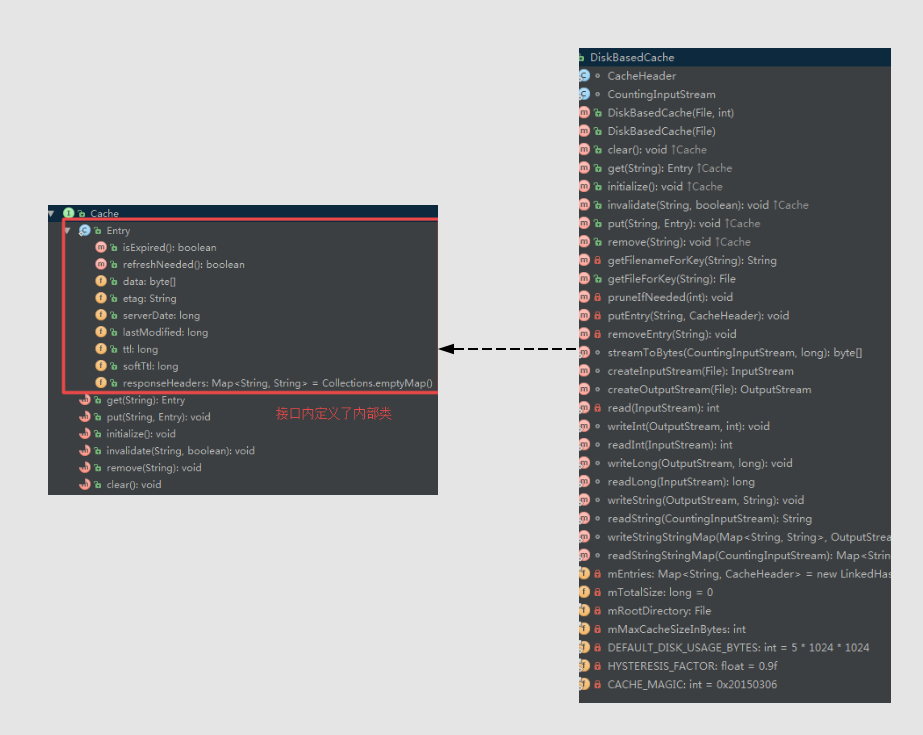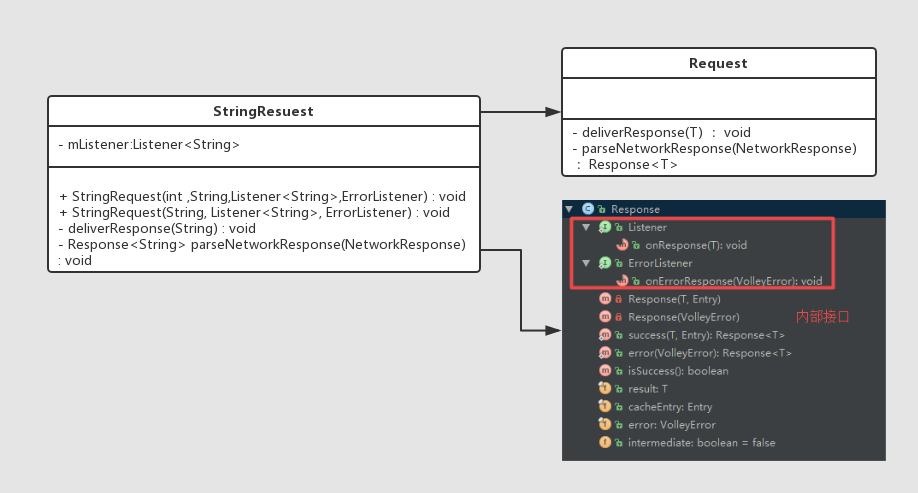201709011工作日记--Volley源码详解(二)
1.Cache接口和DiskBasedCache实现类
首先,DiskBasedCache类是Cache接口的实现类,因此我们需要先把Cache接口中的方法搞明白。

首先分析下Cache接口中的东西,首先是接口的内部类 class entry{},用途是返回缓存的数据,下面是内部类的具体实现:
class Entry {
/**
* 从缓存中返回的数据
* The data returned from cache.
* */
public byte[] data;
/**
* 缓存一致性
* ETag for cache coherency. */
public String etag;
/**
* 从服务端返回的响应数据
* Date of this response as reported by the server. */
public long serverDate;
/**
* 请求的最后修改时间
* The last modified date for the requested object. */
public long lastModified;
/**
* 记录的TTL值。IP包被路由器丢弃之前允许通过的最大网段数量
* 作用是限制IP数据包在计算机网络中的存在的时间,IP数据包在计算机网络中可以转发的最大跳数
* TTL for this record. */
public long ttl;
/** Soft TTL for this record. */
public long softTtl;
/** Immutable response headers as received from server; must be non-null. */
public Map<String, String> responseHeaders = Collections.emptyMap();
/**过期,返回true
* True if the entry is expired. */
public boolean isExpired() {
return this.ttl < System.currentTimeMillis();
}
/**
* 如果需要从数据源跟新数据则返回TRUE
* True if a refresh is needed from the original data source. */
public boolean refreshNeeded() {
return this.softTtl < System.currentTimeMillis();
}
}
上面的是在接口中定义了一个内部类Entry,这种情况之前没见过,还不知道有什么具体作用,下面是接口内部类举例:
public class QuestionMain implements ITest{
public static void main(String[] args) {
ITest.TestInternal.test(new QuestionMain());
}
@Override
public void print() {
System.out.println("真正实现方法");
}
}
interface ITest {
void print();
public static class TestInternal {
public static void test(ITest test) {
test.print();
}
}
}
链接中有一点点相关讨论,但是仍然不知道有啥作:http://www.th7.cn/Program/java/201412/329066.shtmlhttp://bbs.csdn.net/topics/390735550
我的一点理解是:由于接口中的所有方法都需要重写,但是有些方法不想重写的话可以放到接口内部类中去。
接口 Cache 里面封装了一个静态内部类 Entry(登记),这个内部类非常重要,看了 HTTP 协议的同学们会发现,Entry 里面定义的这些成员变量跟 headers(消息报头)里面关于缓存的标签是一样的,这也是前面强调要看协议的原因。其中还维护了一个map 用来保存消息报头中的 key / value,data 来保存 entity 消息实体。除此之外就是一些集合操作了。接口的内部类 Entry,他真的太重要了,我们看连个判断过期和需要刷新的方法分别是,两个成员变量跟当前时间的对比。而 data 是二进制数组,我们都知道在 HTTP 中 start line 和 headers 是明文存储的,而 Entity 是没有规定的,一般我们都用二进制流传输,可以减少传输流量,并且安全,data 这里就是用来保存 Entity 的。
这个接口的作用就是对外提供一个查询、存入、删除缓存条目的作用。
Cache 的默认实现是 DiskBasedCache,实现类的目的是:类的目的是 将文件直接缓存到指定目录中的硬盘上的缓存实现。
参数与初始化函数:
/**
* 缓存条目
* Map of the Key, CacheHeader pairs */
private final Map<String, CacheHeader> mEntries =
new LinkedHashMap<String, CacheHeader>(16, .75f, true); /**
* 目前所使用到的缓存字节数组
* Total amount of space currently used by the cache in bytes. */
private long mTotalSize = 0; /**
* 缓存的根目录
* The root directory to use for the cache. */
private final File mRootDirectory; /**
* 缓存的最大字节数组
* The maximum size of the cache in bytes. */
private final int mMaxCacheSizeInBytes; /**
* 默认的最大硬盘缓存
* Default maximum disk usage in bytes. */
private static final int DEFAULT_DISK_USAGE_BYTES = 5 * 1024 * 1024; /** High water mark percentage for the cache */
private static final float HYSTERESIS_FACTOR = 0.9f; /** Magic number for current version of cache file format. */
private static final int CACHE_MAGIC = 0x20150306; /**缓存根目录,最大缓存字节数
* Constructs an instance of the DiskBasedCache at the specified directory.
* @param rootDirectory The root directory of the cache.
* @param maxCacheSizeInBytes The maximum size of the cache in bytes.
*/
public DiskBasedCache(File rootDirectory, int maxCacheSizeInBytes) {
mRootDirectory = rootDirectory;
mMaxCacheSizeInBytes = maxCacheSizeInBytes;
} /**
* Constructs an instance of the DiskBasedCache at the specified directory using
* the default maximum cache size of 5MB.
* @param rootDirectory The root directory of the cache.
*/
public DiskBasedCache(File rootDirectory) {
this(rootDirectory, DEFAULT_DISK_USAGE_BYTES);
}
针对缓存数据的处理:
/**
* 清空缓存,并将缓存目录下面的所有缓存文件删除
* Clears the cache. Deletes all cached files from disk.
*/
@Override
public synchronized void clear() {
File[] files = mRootDirectory.listFiles();
if (files != null) {
for (File file : files) {
file.delete();
}
}
mEntries.clear();
mTotalSize = 0;
VolleyLog.d("Cache cleared.");
} /**
* 利用指定----key,去获取缓存条目
* Returns the cache entry with the specified key if it exists, null otherwise.
*/
@Override
public synchronized Entry get(String key) {
CacheHeader entry = mEntries.get(key);
// if the entry does not exist, return.
//缓存为空则直接返回
if (entry == null) {
return null;
}
File file = getFileForKey(key);
try {
CountingInputStream cis = new CountingInputStream(
new BufferedInputStream(createInputStream(file)), file.length());
try {
CacheHeader entryOnDisk = CacheHeader.readHeader(cis);
if (!TextUtils.equals(key, entryOnDisk.key)) {
// File was shared by two keys and now holds data for a different entry!
VolleyLog.d("%s: key=%s, found=%s",
file.getAbsolutePath(), key, entryOnDisk.key);
// Remove key whose contents on disk have been replaced.
removeEntry(key);
return null;
}
byte[] data = streamToBytes(cis, cis.bytesRemaining());
return entry.toCacheEntry(data);
} finally {
// Any IOException thrown here is handled by the below catch block by design.
//noinspection ThrowFromFinallyBlock
cis.close();
}
} catch (IOException e) {
VolleyLog.d("%s: %s", file.getAbsolutePath(), e.toString());
remove(key);
return null;
}
} /**
* Initializes the DiskBasedCache by scanning for all files currently in the
* specified root directory. Creates the root directory if necessary.
*/
@Override
public synchronized void initialize() {
if (!mRootDirectory.exists()) {
if (!mRootDirectory.mkdirs()) {
VolleyLog.e("Unable to create cache dir %s", mRootDirectory.getAbsolutePath());
}
return;
}
File[] files = mRootDirectory.listFiles();
if (files == null) {
return;
}
for (File file : files) {
try {
long entrySize = file.length();
CountingInputStream cis = new CountingInputStream(
new BufferedInputStream(createInputStream(file)), entrySize);
try {
CacheHeader entry = CacheHeader.readHeader(cis);
// NOTE: When this entry was put, its size was recorded as data.length, but
// when the entry is initialized below, its size is recorded as file.length()
entry.size = entrySize;
putEntry(entry.key, entry);
} finally {
// Any IOException thrown here is handled by the below catch block by design.
//noinspection ThrowFromFinallyBlock
cis.close();
}
} catch (IOException e) {
//noinspection ResultOfMethodCallIgnored
file.delete();
}
}
} /**
* Invalidates an entry in the cache.
* @param key Cache key
* @param fullExpire True to fully expire the entry, false to soft expire
*/
@Override
public synchronized void invalidate(String key, boolean fullExpire) {
Entry entry = get(key);
if (entry != null) {
entry.softTtl = 0;
if (fullExpire) {
entry.ttl = 0;
}
put(key, entry);
}
} /**
* Puts the entry with the specified key into the cache.
*/
@Override
public synchronized void put(String key, Entry entry) {
pruneIfNeeded(entry.data.length);
File file = getFileForKey(key);
try {
BufferedOutputStream fos = new BufferedOutputStream(createOutputStream(file));
CacheHeader e = new CacheHeader(key, entry);
boolean success = e.writeHeader(fos);
if (!success) {
fos.close();
VolleyLog.d("Failed to write header for %s", file.getAbsolutePath());
throw new IOException();
}
fos.write(entry.data);
fos.close();
putEntry(key, e);
return;
} catch (IOException e) {
}
boolean deleted = file.delete();
if (!deleted) {
VolleyLog.d("Could not clean up file %s", file.getAbsolutePath());
}
} /**
* Removes the specified key from the cache if it exists.
*/
@Override
public synchronized void remove(String key) {
boolean deleted = getFileForKey(key).delete();
removeEntry(key);
if (!deleted) {
VolleyLog.d("Could not delete cache entry for key=%s, filename=%s",
key, getFilenameForKey(key));
}
} /**为指定的缓存键创建伪唯一文件名。利用key,创建key相关的文件名
* Creates a pseudo-unique filename for the specified cache key.
* @param key The key to generate a file name for.
* @return A pseudo-unique filename.
*/
private String getFilenameForKey(String key) {
int firstHalfLength = key.length() / 2;
String localFilename = String.valueOf(key.substring(0, firstHalfLength).hashCode());
localFilename += String.valueOf(key.substring(firstHalfLength).hashCode());
return localFilename;
} /**
* 根据给定的缓存键,创建该文件,并返回该键对应的文件对象
* Returns a file object for the given cache key.
*/
public File getFileForKey(String key) {
return new File(mRootDirectory, getFilenameForKey(key));
} /**
* 修剪缓存以适应指定的字节数
* Prunes the cache to fit the amount of bytes specified.
* @param neededSpace The amount of bytes we are trying to fit into the cache.
*/
private void pruneIfNeeded(int neededSpace) {
//如果已经用的和需要用的大小,小于最大缓存字节数,则直接返回
if ((mTotalSize + neededSpace) < mMaxCacheSizeInBytes) {
return;
}
if (VolleyLog.DEBUG) {
VolleyLog.v("Pruning old cache entries.");
} long before = mTotalSize;
int prunedFiles = 0;
long startTime = SystemClock.elapsedRealtime(); Iterator<Map.Entry<String, CacheHeader>> iterator = mEntries.entrySet().iterator();
while (iterator.hasNext()) {
Map.Entry<String, CacheHeader> entry = iterator.next();
CacheHeader e = entry.getValue();
boolean deleted = getFileForKey(e.key).delete();
if (deleted) {
mTotalSize -= e.size;
} else {
VolleyLog.d("Could not delete cache entry for key=%s, filename=%s",
e.key, getFilenameForKey(e.key));
}
iterator.remove();
prunedFiles++; if ((mTotalSize + neededSpace) < mMaxCacheSizeInBytes * HYSTERESIS_FACTOR) {
break;
}
} if (VolleyLog.DEBUG) {
VolleyLog.v("pruned %d files, %d bytes, %d ms",
prunedFiles, (mTotalSize - before), SystemClock.elapsedRealtime() - startTime);
}
} /**
* 利用特定的key去添加缓存条目
* Puts the entry with the specified key into the cache.
* @param key The key to identify the entry by.
* @param entry The entry to cache.
*/
private void putEntry(String key, CacheHeader entry) {
//存入条目之前需要需要更改缓存容量的大小
if (!mEntries.containsKey(key)) {
mTotalSize += entry.size;
} else {
CacheHeader oldEntry = mEntries.get(key);
mTotalSize += (entry.size - oldEntry.size);
}
mEntries.put(key, entry); //存入缓存条目
} /**
* 删除缓存并且更改缓存大小
* Removes the entry identified by 'key' from the cache.
*/
private void removeEntry(String key) {
CacheHeader removed = mEntries.remove(key);
if (removed != null) {
mTotalSize -= removed.size;
}
}
实现类里面还有一个静态内部类CacheHeader,作用是将缓存一个条目。其中pruneIfNeeded()方法是在 put 方法的第一行执行的,做的就是这件事,Volley 并没有使用 LRU。而是使用的 FIFO。DiskBasedCache 剩下的就是一些文件操作了,就不挨着看了。
这里顺便提一下内部接口,具体例子在Response.java这个类中,存在着两个接口:
/** Callback interface for delivering parsed responses. 传递相应信息时,回调此接口*/
public interface Listener<T> {
/** Called when a response is received. */
void onResponse(T response);
} /** Callback interface for delivering error responses. 传递错误响应信息时,回调此接口*/
public interface ErrorListener {
/**
* Callback method that an error has been occurred with the
* provided error code and optional user-readable message.
*/
void onErrorResponse(VolleyError error);
}
看下内部接口的使用场景:
package com.dao.util;
public class Util {
public interface Worker {
void work();
}
}
package com.dao.util;
import com.dao.util.Util.Worker;
public class Demo implements Worker {
public void work() {
System.out.println("Is working");
}
}
在这个util类里面封装了会改变的Worker,也就是说,util类里面有自己的算法:一部分是固定,另外一部分是可变的,而这个可变的部分就变成了一个接口,接口是特殊的抽象类~其实的意思大概的这个worker可能在不同的工作环境有不同的工作方式,所以在类里面放一个接口不是什么新的设计,而是一种思想方式,让代码扩展性更高。
2. 创建一个 StringRequest 请求
这个是我们发起的请求,我们可以注意上边的方法有四个参数的方法,(int method, String url, Listener listener,ErrorListener errorListener) ,我们可以主要关注一个后边的两个回调,一个是成功的回调,一个是失败的回调,而且我们可以看一下他的源码。如下为利用构造函数创建的一个StringRequest请求代码:
StringRequest stringRequest = new StringRequest("http://www.baidu.com",
new Response.Listener<String>() {
@Override
public void onResponse(String response) {
}
}, new Response.ErrorListener() {
@Override
public void onErrorResponse(VolleyError error) {
}
});
先看下StringRequest继承了Request类,需要实现其中的两个抽象方法;在构造函数中需要两个回调函数。他们之间的关系如下:

StringRequest类:
/**
* 一个用于在给定URL中以String形式检索响应正文的请求。
* A canned request for retrieving the response body at a given URL as a String.
*/
public class StringRequest extends Request<String> {
private final Listener<String> mListener; /**
* 利用给定的方式创造一个请求消息
* Creates a new request with the given method.
*
* @param method the request {@link Method} to use 请求方式
* @param url URL to fetch the string at 用于获取字符串的URL
* @param listener Listener to receive the String response 侦听器接收String响应
* @param errorListener Error listener, or null to ignore errors 错误侦听器,或null忽略错误
*/
public StringRequest(int method, String url, Listener<String> listener,
ErrorListener errorListener) {
super(method, url, errorListener);
mListener = listener;
} /**
* 使用指定的GET方式创建新的请求消息
* Creates a new GET request.
*
* @param url URL to fetch the string at
* @param listener Listener to receive the String response
* @param errorListener Error listener, or null to ignore errors
*/
public StringRequest(String url, Listener<String> listener, ErrorListener errorListener) {
this(Method.GET, url, listener, errorListener);
} /**
* 将解析到的响应传送给他们的监听器,给定的响应response保证为非空值;
* 无法解析的响应不会传递。
* @param response The parsed response returned by
*/
@Override
protected void deliverResponse(String response) {
if (mListener != null) {
mListener.onResponse(response);
}
}
/**
* 工作线程将会调用这个方法
* 方法的目的是:按照HTTP头消息中的编码字符集,去重新构建这个消息的返回信息
*
* new String(byte[],"UTF-8")是新建了一个UTF-8编码的字符串
*
* @param response Response from the network
* @return 返回成功响应的消息
*/
@Override
protected Response<String> parseNetworkResponse(NetworkResponse response) {
String parsed;
try {
//解析头部信息的编码格式,然后将返回信息按照编码格式进行转换
parsed = new String(response.data, HttpHeaderParser.parseCharset(response.headers));
} catch (UnsupportedEncodingException e) {//如果指定字符集不受支持
parsed = new String(response.data);
}
return Response.success(parsed, HttpHeaderParser.parseCacheHeaders(response));
}
}
Response类的内部接口:
public class Response<T> {
/** Callback interface for delivering parsed responses. 传递相应信息时,回调此接口*/
public interface Listener<T> {
/** Called when a response is received. */
void onResponse(T response);
}
/** Callback interface for delivering error responses. 传递错误响应信息时,回调此接口*/
public interface ErrorListener {
/**
* Callback method that an error has been occurred with the
* provided error code and optional user-readable message.
*/
void onErrorResponse(VolleyError error);
}
201709011工作日记--Volley源码详解(二)的更多相关文章
- 201709011工作日记--Volley源码详解(三)
1. RequestQueue类 我们使用 Volley 的时候创建一个 request 然后把它丢到 RequestQueue 中就可以了.那么来看 RequestQueue 的构造方法,含有四个参 ...
- 20170908工作日记--Volley源码详解
Volley没有jar包,需要从官网上下载源码自己编译出来,或者做成相关moudle引入项目中.我们先从最简单的使用方法入手进行分析: //创建一个网络请求队列 RequestQueue reques ...
- 201709021工作日记--Volley源码详解(五)
学习完了CacheDispatcher这个类,下面我们看下NetworkDispatcher这个类的具体细节,先上代码: /** * 提供一个线程执行网络调度的请求分发 * Provides a th ...
- 201709021工作日记--Volley源码解读(四)
接着volley源码(三)继续,本来是准备写在(三)后面的,但是博客园太垃圾了,写了半天居然没保存上,要不是公司这个博客还没被限制登陆,鬼才用这个...真是垃圾 继续解读RequestQueue的源码 ...
- 20170906工作日记--volley源码的相关方法细节学习
1. 在StringRequest类中的75行--new String();使用方法 /** * 工作线程将会调用这个方法 * @param response Response from the ne ...
- OkHttp3源码详解(二) 整体流程
1.简单使用 同步: @Override public Response execute() throws IOException { synchronized (this) { if (execut ...
- Activiti架构分析及源码详解
目录 Activiti架构分析及源码详解 引言 一.Activiti设计解析-架构&领域模型 1.1 架构 1.2 领域模型 二.Activiti设计解析-PVM执行树 2.1 核心理念 2. ...
- 源码详解系列(六) ------ 全面讲解druid的使用和源码
简介 druid是用于创建和管理连接,利用"池"的方式复用连接减少资源开销,和其他数据源一样,也具有连接数控制.连接可靠性测试.连接泄露控制.缓存语句等功能,另外,druid还扩展 ...
- [转]【视觉 SLAM-2】 视觉SLAM- ORB 源码详解 2
转载地址:https://blog.csdn.net/kyjl888/article/details/72942209 1 ORB-SLAM2源码详解 by 吴博 2 https://github.c ...
随机推荐
- mongodb基础学习13-聚集aggregate操作
aggregate可以用的操作与sql的对应关系 下面来看具体操作例子: 分组求和: 求总记录数 商品价格大于50记录分组求和 商品价格大于50且分组记录大于2的分组记录条件 分组库存数,并按库存排序 ...
- mysql之MMM高可用方案简介
MMM(Master-Master Replication Manager for MySQL) MySQL主主复制管理器,提供了MySQL主主复制配置的监控.故障转移和管理的一套可伸缩的脚本套件.在 ...
- chattr与lsattr命令
这两个命令是用来查看和改变文件.目录属性的,与chmod这个命令相比,chmod只是改变文件的读写.执行权限,更底层的属性控制是由chattr来改变的. chattr命令的用法:chattr [ -R ...
- Swift 4 新特性
多行字符串 /// 多行字符串用三引号括起来 let quotation = """ The White Rabbit put on his spectacles. &q ...
- delphi实现两个目录路径的链接
filepath := PathJoin(['C:', 'path1', 'path2\', 'a.doc']); // filepath = 'C:\path1\path2\a.doc' 代码: f ...
- scala-学习 2
列表操作 List() 或者是 Nil 空list scala> val a = List() a:List[Nothing] = List() print(a.length) a.length ...
- Java web struct入门基础知识
1.Struts2的前身是Opensymphony的Webwork2,实际上Strut和Webwork2合并后形成Struts2. 2.一个HelloWord示例 1)创建Web应用,所需要的Ja ...
- 数据类型-Series
数据类型-Series Series数据类型由一组数据和数据相关的索引组成,键 -> 值 Series数据类型可视为:一维 带标签 数组 Series基本操作类似数组和字典 Series数据类型 ...
- python数据分析笔记——数据加载与整理]
[ python数据分析笔记——数据加载与整理] https://mp.weixin.qq.com/s?__biz=MjM5MDM3Nzg0NA==&mid=2651588899&id ...
- 断开的管道 java.io.IOException: Broken pipe 解决方法
一.Broken pipe产生原因分析 1.当访问某个服务突然服务器挂了,就会产生Broken pipe; 2.客户端读取超时关闭了连接,这时服务器往客户端再写数据就发生了broken pipe异常! ...
